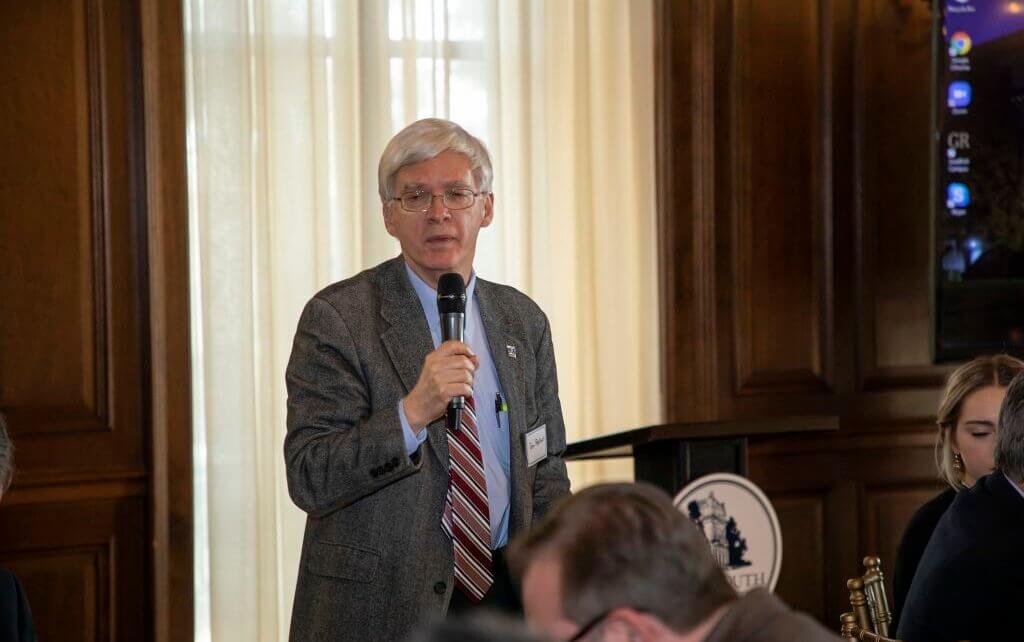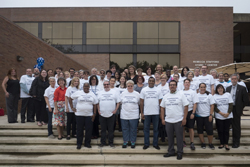After 44 years at Monmouth University, 22 of which were spent as Provost and Vice President for Academic Affairs, Thomas Pearson, Ph.D., announced his retirement as a full-time faculty member in the Department of History and Anthropology.
Pearson, who first joined the department in 1978, served as Provost and Vice President for Academic Affairs under four different presidents from 1992 to 2014 after serving as the Chair of the History Department and Chair of the Faculty Council from 1981 to 1987 and again from 1989 to 1992. Notably, Monmouth College became Monmouth University in 1995 under Pearson’s provostship.
“The day we became a University, which happened pretty early in my provostship, was a wonderful day,” described Pearson. “It was the dawn of a new era.”
He described the lengthy application process that began in 1993 under President Rebecca Stafford. In order to qualify for University status, Monmouth had to designate graduate faculty, set up academic schools, and put together the fundamental infrastructure and organization of a University.
“There was a lot of concern that University status would change our connectivity to students,” explained Pearson. “What a lot of people loved about Monmouth College was the sense that students could really get to know the faculty members and so forth, and there was some concern that a University title sounded really big and foreboding.”
Even after obtaining university status, Pearson said that it took about five years for Monmouth College to start feeling like Monmouth University. Still, he noted that the school was able to “operate at a higher level while maintaining the essence of the student-teacher relationship that was the foundation of Monmouth College.”
“By so many measures, this is such a different place. Transformation has been the name of the game, but I was lucky enough during a key period when enrollment came up, academic quality came up, financially we were in good shape, and we had a lot of other colleges and universities talking about the Monmouth story. I was lucky enough to be part of the process in which we brought together a lot of the building blocks of today’s University.”
Pearson played an integral role in this transformation process, especially during his time as Provost. Notably, he helped to establish the Schlaefer School, the Graduate School, the School of Science, the School of Nursing and Health Studies, the School of Social Work, the Honors School, and the Center for Excellence in Teaching and Learning. Pearson also oversaw the hiring of 415 full-time faculty and 21 deans.
“If you had a kind of infra-red light to shine on our institution – its history, its culture, its progress from Monmouth College to Monmouth University – you’d discover so many instances of his handiwork most of us don’t even know about,” said Christopher DeRosa, Ph.D., Associate Professor and Chair of the Department of History and Anthropology. “If there’s a central thread to his contribution, it might be this: Professor Pearson always believed that Monmouth students were capable of meeting high standards. So for a couple of generations of students and colleagues, that is where he set them.”
“While Dr. Pearson’s accomplishments are impressive—hiring many new faculty members, founding schools and institutes, reforming General Education, developing new undergraduate and graduate programs, advancing global initiatives, just to name a few—what is equally remarkable is how he enabled his colleagues in Academic Affairs and beyond to reach their potential,” added Saliba Sarsar, Ph.D., Professor of Political Science. “It is how he gave substance to attributes of Monmouth’s organizational life, including access, accountability, civility, collegiality, competence, hope, resilience, and truth. It is how he kept a steady hand at the helm of Academic Affairs amid the higher administrative transitions and the financial challenges.”
“Dr. Pearson’s legacy as Provost is found in the positive organizational trajectory he established, the standards he set, the professional relationships he formed, and the confident actions of many colleagues,” Sarsar continued.
“Dr. Pearson’s twenty-two years of service is especially impressive given that a typical provost serves around five years in the position,” added Datta Naik, Ph.D., Professor of Chemistry.
Despite serving over two decades as Provost, Pearson’s true passion is in the classroom. “I love teaching. Even during the years that I was Provost, I taught one course every semester, which is not typical for a Provost because it’s a pretty big job and there’s a lot of strategizing and resource-providing and so forth, but it was really important for me.”
“Being the Provost was a great privilege and an honor,” he continued. “I didn’t always think of it that way because it’s pretty heavy lifting, but I got to meet so many of my faculty colleagues and I got to get to know Trustees and students. I got to learn how the place ran. The most important thing is that I was part of it.”
Pearson emphasized the importance of faculty scholars, which he has embodied over the course of his career through his continued research about Russian history and culture, even during his time as Provost. “It has been my passion and in many ways my lifeline,” he explained, noting that he has structured many of his courses around his experiences from his several trips to Russia with Monmouth students and faculty over the years. Although Pearson is stepping down as a full-time faculty member, he will return to the University next year as an adjunct professor to continue teaching Russian History.
“Under President Stafford, Dr. Pearson led the successful effort to strengthen and promote faculty research by establishing a reduced teaching load for faculty engaged in scholarship,” added Naik.
Pearson also encourages students to develop lasting relationships and personal connections with faculty. Furthermore, he noted that the relationships he has developed with students and faculty over the years have been his favorite part of his time at Monmouth University.
“He embodies the caring and community spirit of Monmouth. He has an astonishing memory, knowing the name of every single faculty member, including correct pronunciation,” described Frederick McKitrick, Ph.D., Associate Professor of History and Chair of the Department of Art and Design. “And when he wrote letters of support for us – for tenure or promotion – they were never simply pro forma, but always spoke to who we were. This connection has been so important in making Monmouth a cohesive community.”
“Tom Pearson is a much admired colleague, and we are going to miss him in more ways than I can say,” said DeRosa.
“I am most grateful to Dr. Pearson for his mentorship and guidance during our administrative years and wish him a happy and fulfilling retirement,” concluded Naik.




